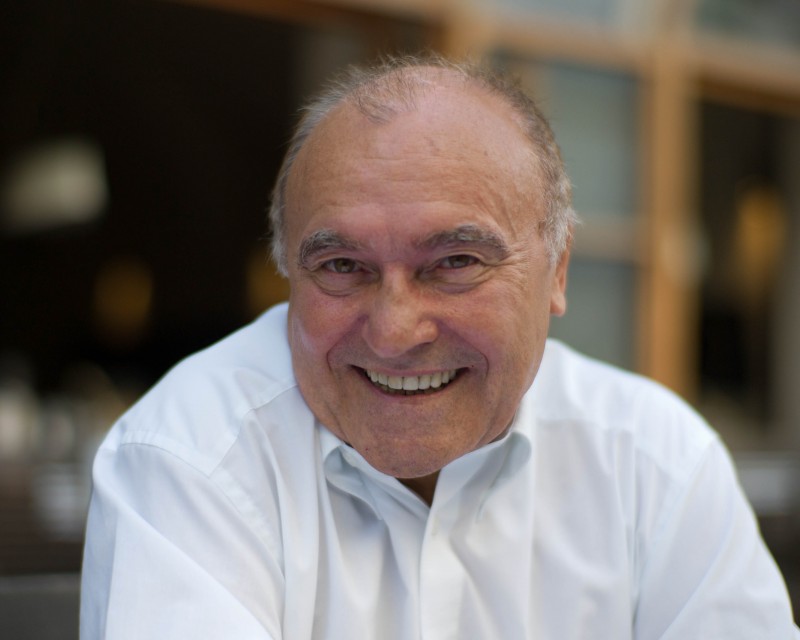In this interview conducted by Creative Region Linz & Upper Austria, Ars Electronica co-founder Hannes Leopoldseder discusses the factors that went into Linz’s transition from a steel town to a center of media art.

How did you come up with the idea to establish a media arts festival in late 1970s Linz?
Hannes Leopoldseder: When a journalist of the Wall Street Journal reported on Ars Electronica a few years ago, he asked exactly the same question: why did Ars Electronica happen in Austria, a country that is identified with historical art and music, and why Linz, a city known for iron and steel? I always come across this particular question, whether I am giving lectures in Shanghai, China, in Gwangju, a very ambitious city of culture in South Korea, or in Tehran, Iran: why in Linz? My answer sounds simple but it isn’t: we – that was the computer mathematician Hubert Bognermayr and I – came up with the idea for Ars Electronica, and politicians in Linz believed in it and backed it financially. Apparently there was something in addition: timing. Or as Victor Hugo, the great nineteenth-century novelist, said: “Nothing is more powerful than an idea whose time has come” – that time was the year 1979.
What social and cultural role did you want Ars Electronica to play?
We use microelectronics to establish Linz’s future urban identity. Electronics as the raw material of the future.
After the Second World War, Linz was a steel city plagued with environmental problems from which it was, however, determined to rise with a tremendous upswing. VOEST invested to radically improve air quality. The Johannes Kepler University, the Linz Art University, the Brucknerhaus concert hall were founded. Helmuth Gsöllpointner’s Forum Metall in 1977 and Forum Design in 1979 showed the way to the future. With Ars Electronica, Bognermayr and I sought to go even further. A symposium on music, video and electronics scheduled to take place at the Brucknerhaus was our chance. Our idea: we push the boundaries. We put aside iron and steel. We use microelectronics to establish Linz’s future urban identity. Electronics as the raw material of the future.
Moreover, there was a second idea that meant a lot to me as an ORF journalist: if we organize a festival including conferences, exhibitions and concerts, it simply cannot be an isolated special event for industry professionals. I wanted to get the entire city involved. As such, it was necessary to identify a project that would fit in with the then social-democratic motto “culture for everyone,” taken from the title of the book published in 1979 by Hilmar Hoffmann, head of the Frankfurt City Cultural Department. By coincidence, I met the composer and musician Walter Haupt of the Bavarian State Opera. Based on an open-air concert, Walter Haupt performed the “Linzer Klangwolke (Cloud of Sound)” in a Bavarian village we developed together, a quadrophonic open-air event with Anton Bruckner’s Eight Symphony set to take place at the Linz Donaupark. By the Munich scientist and artist Herbert W. Franke we found a partner to oversee the symposium and the exhibition. Ulrich Rützel took care of marketing.
Art, technology and society eventually crystallized into the overall festival guideline, a guideline that still holds strong even now, after three decades have passed. On top of which, however, the “future” rises as the festival’s key term – the future of life, of humankind, of the world.
What are your memories of the festival premiere? What made the launch so special for Ars Electronica to become such a success story?
Hannes Leopoldseder: On 18 September 1979, robot SPA 12 opened the festival. We asked the people of Linz to place their TV sets into the open windows to broadcast the Bruckner music all over town. Linz turned into the “City of Sound.” One hundred thousand people turned up at the Donaupark to listen to the Linzer Klangwolke. An unprecedented event.
The date of 18 September with those 100.000 individuals partaking in a Bruckner symphony marks a pivotal point in the expansion of Linz’s identity from that of an industrial city to that of a cultural city uniquely positioned between Vienna and Salzburg. The media coverage of the first Ars Electronica Festival completely blew our minds. DER SPIEGEL (“Swinging Toni”), the Süddeutsche, the FAZ, DIE ZEIT, all the tabloids reported on more than 100.000 people at a Bruckner symphony performance and on this new festival opened by the Klangwolke – and a robot.
How has Ars Electronica developed into the international figurehead of the City of Linz that it is today?
Hannes Leopoldseder: Just like any other type of product, a festival constantly requires new input. I could personally add two more ideas over the course of the following decades: in 1987, I came up with the idea for Prix Ars Electronica, today perhaps the most prestigious digital media award worldwide. And in 1991 I had the idea for the construction of the first Ars Electronica Center, which opened in 1996. Mayor Dr. Franz Dobusch made it possible to extend the center on the occasion of 2009 Linz European Capital of Culture. The new Ars Electronica Center (AEC) covers 6,700 m2 of space. Today, the AEC is a corporation owned by the City of Linz. Artistic director Gerfried Stocker, CFO Diethard Schwarzmair and 140 employees are responsible for maintaining the company’s innovative leadership role. Linz has positioned itself as a modern city of work, industry and life, as a city of the future. Since 1 December 2014, Linz is a member of the international UNESCO Creative Cities Network with a focus on “Media Arts”. The honor awarded by UNESCO is another milestone on the path to Linz – City of the Future.



